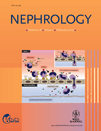Characteristics and clinical outcomes of hyponatraemia in peritoneal dialysis patients
Abstract
Aim
There are few reports on the incidence, aetiology, and mortality of peritoneal dialysis (PD) patients with hyponatraemia.
Methods
We identified all adults (>18-years-of-age) who received PD between May 2001 and March 2010. The patients were divided into two groups according to the presence of hyponatraemia (<135 mmol/L) during follow-up. Total body water (TBW) was obtained from bioimpedance analysis. Appropriate water gain was defined as a more than 3.6% increase of the mean TBW during normonatraemia in the same patient. Aetiologies of hyponatraemia were divided into two classes according to TBW.
Results
Three hundred and eighty seven patients were enrolled in this study. Ninety nine had normonatraemia and 288 developed hyponatraemia during follow-up. Among 241 episodes with simultaneous bioelectrical impedance analysis measurement, there were 71 cases with appropriate water gain and 170 cases with non-appropriate water gain. Low residual renal function and long duration of PD were associated with development of hyponatraemia by appropriate water gain. On multivariate analysis, old age (≥65-years-of-age), hypoalbuminaemia (<35 g/L), low residual renal function (<2 mL/min per 1.732) and a high comorbid condition were associated with mortality in the PD patients. The patients with intermediate and high Davies index had an odds ratio of 3.25 for development of hyponatraemia during the follow-up period (95% confidence interval, 2.025–5.215; P < 0.001).
Conclusion
The prevalence of hyponatraemia increases along with the increased comorbidity status. The comorbidity conditions may be more important than hyponatraemia per se for predicting mortality. Additionally, the preservation of residual renal function may play a role in preventing hyponatraemia.




